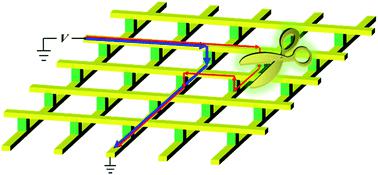当前位置:
X-MOL 学术
›
Nanoscale Adv.
›
论文详情
Our official English website, www.x-mol.net, welcomes your
feedback! (Note: you will need to create a separate account there.)
Research progress on solutions to the sneak path issue in memristor crossbar arrays
Nanoscale Advances ( IF 4.6 ) Pub Date : 2020-03-11 , DOI: 10.1039/d0na00100g Lingyun Shi 1 , Guohao Zheng 1 , Bobo Tian 1, 2 , Brahim Dkhil 2 , Chungang Duan 1, 3
Nanoscale Advances ( IF 4.6 ) Pub Date : 2020-03-11 , DOI: 10.1039/d0na00100g Lingyun Shi 1 , Guohao Zheng 1 , Bobo Tian 1, 2 , Brahim Dkhil 2 , Chungang Duan 1, 3
Affiliation

|
Since the emergence of memristors (or memristive devices), how to integrate them into arrays has been widely investigated. After years of research, memristor crossbar arrays have been proposed and realized with potential applications in nonvolatile memory, logic and neuromorphic computing systems. Despite the promising prospects of memristor crossbar arrays, one of the main obstacles for their development is the so-called sneak-path current causing cross-talk interference between adjacent memory cells and thus may result in misinterpretation which greatly influences the operation of memristor crossbar arrays. Solving the sneak-path current issue, the power consumption of the array will immensely decrease, and the reliability and stability will simultaneously increase. In order to suppress the sneak-path current, various solutions have been provided. So far, some reviews have considered some of these solutions and established a sophisticated classification, including 1D1M, 1T1M, 1S1M (D: diode, M: memristor, T: transistor, S: selector), self-selective and self-rectifying memristors. Recently, a mass of studies have been additionally reported. This review thus attempts to provide a survey on these new findings, by highlighting the latest research progress realized for relieving the sneak-path issue. Here, we first present the concept of the sneak-path current issue and solutions proposed to solve it. Consequently, we select some typical and promising devices, and present their structures and properties in detail. Then, the latest research activities focusing on single-device structures are introduced taking into account the mechanisms underlying these devices. Finally, we summarize the properties and perspectives of these solutions.
中文翻译:

忆阻器交叉阵列潜行路径问题解决方法研究进展
自从忆阻器(或忆阻器件)出现以来,如何将它们集成到阵列中已被广泛研究。经过多年的研究,忆阻器交叉阵列已经被提出并实现,在非易失性存储器、逻辑和神经形态计算系统中具有潜在的应用。尽管忆阻器交叉阵列的前景广阔,但其发展的主要障碍之一是所谓的潜行电流会导致相邻存储单元之间的串扰干扰,从而可能导致误解,从而极大地影响忆阻器交叉阵列的操作。解决潜路电流问题,阵列的功耗将大幅降低,可靠性和稳定性也将同时提高。为了抑制潜行电流,已经提供了各种解决方案。到目前为止,一些评论已经考虑了其中一些解决方案并建立了复杂的分类,包括1D1M、1T1M、1S1M(D:二极管、M:忆阻器、T:晶体管、S:选择器)、自选和自整流忆阻器。最近,大量研究被补充报道。因此,本综述试图通过强调为缓解潜行路径问题而实现的最新研究进展,对这些新发现进行调查。在这里,我们首先提出潜行路径当前问题的概念以及提出的解决方案。因此,我们选择了一些典型的和有前途的器件,并详细介绍了它们的结构和性能。然后,介绍了关注单器件结构的最新研究活动,并考虑到这些器件背后的机制。最后,我们总结了这些解决方案的属性和观点。
更新日期:2020-03-11
中文翻译:

忆阻器交叉阵列潜行路径问题解决方法研究进展
自从忆阻器(或忆阻器件)出现以来,如何将它们集成到阵列中已被广泛研究。经过多年的研究,忆阻器交叉阵列已经被提出并实现,在非易失性存储器、逻辑和神经形态计算系统中具有潜在的应用。尽管忆阻器交叉阵列的前景广阔,但其发展的主要障碍之一是所谓的潜行电流会导致相邻存储单元之间的串扰干扰,从而可能导致误解,从而极大地影响忆阻器交叉阵列的操作。解决潜路电流问题,阵列的功耗将大幅降低,可靠性和稳定性也将同时提高。为了抑制潜行电流,已经提供了各种解决方案。到目前为止,一些评论已经考虑了其中一些解决方案并建立了复杂的分类,包括1D1M、1T1M、1S1M(D:二极管、M:忆阻器、T:晶体管、S:选择器)、自选和自整流忆阻器。最近,大量研究被补充报道。因此,本综述试图通过强调为缓解潜行路径问题而实现的最新研究进展,对这些新发现进行调查。在这里,我们首先提出潜行路径当前问题的概念以及提出的解决方案。因此,我们选择了一些典型的和有前途的器件,并详细介绍了它们的结构和性能。然后,介绍了关注单器件结构的最新研究活动,并考虑到这些器件背后的机制。最后,我们总结了这些解决方案的属性和观点。











































 京公网安备 11010802027423号
京公网安备 11010802027423号